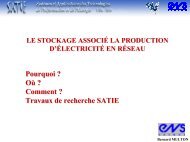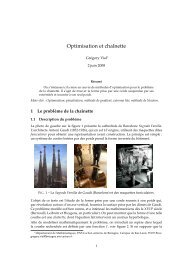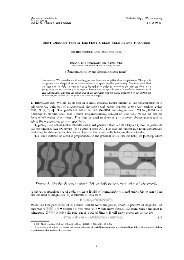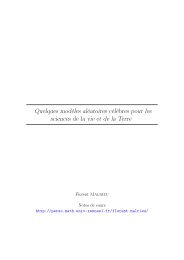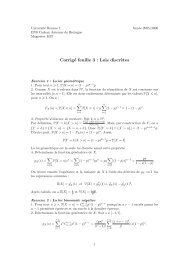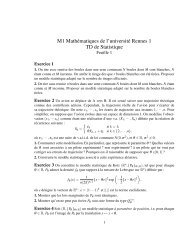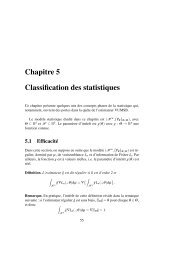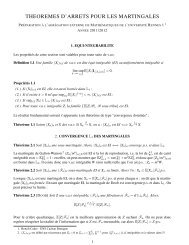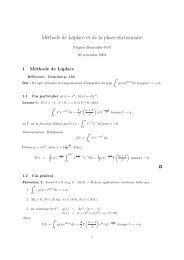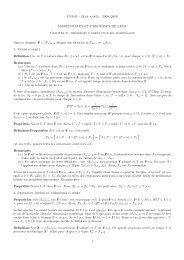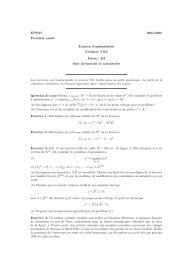Bath Institute For Complex Systems - ENS de Cachan - Antenne de ...
Bath Institute For Complex Systems - ENS de Cachan - Antenne de ...
Bath Institute For Complex Systems - ENS de Cachan - Antenne de ...
You also want an ePaper? Increase the reach of your titles
YUMPU automatically turns print PDFs into web optimized ePapers that Google loves.
2.4 Truncated Karhunen-Loève ExpansionsA starting point for many numerical schemes for PDEs with random coefficients is the approximationof the random field a(ω, x) as a function of a finite number of random variables, a(ω, x) ≈a(ξ 1 (ω), ..., ξ K (ω), x). This is true, for example, for the stochastic collocation method discussed inSection 3.4. Sampling methods, such as Monte–Carlo type methods discussed in Section 4, do notrely on such a finite–dimensional approximation as such, but may make use of such approximationsas a way of producing samples of the input random field.A popular choice to achieve good approximations of this kind for log-normal random fields isthe truncated Karhunen-Loève (KL) expansion. <strong>For</strong> the random field g (as <strong>de</strong>fined in Section 2.2),the KL–expansion is an expansion in terms of a countable set of in<strong>de</strong>pen<strong>de</strong>nt, standard Gaussianrandom variables {ξ n } n∈N . It is given byg(ω, x) =∞∑ √θn b n (x)ξ n (ω),n=1where {θ n } n∈N are the eigenvalues and {b n } n∈N the corresponding normalised eigenfunctions of thecovariance operator with kernel function C(x, y) <strong>de</strong>fined in (2.5). <strong>For</strong> more <strong>de</strong>tails on its <strong>de</strong>rivationand properties, see e.g. [14]. We will here only mention that the eigenvalues {θ n } n∈N are allnon–negative with ∑ n≥0 θ n < +∞.We shall write a(ω, x) as[ ∞]∑ √a(ω, x) = exp θn b n (x)ξ n (ω) ,n=1and <strong>de</strong>note the random fields resulting from truncated expansions by[K∑ √ K]∑ √g K (ω, x) := θn b n (x)ξ n (ω) and a K (ω, x) := exp θn b n (x)ξ n (ω) , for some K ∈ N.n=1The advantage of writing a(ω, x) in this way is that it gives an expression for a(ω, x) in terms ofin<strong>de</strong>pen<strong>de</strong>nt, standard Gaussian random variables.Finally, we <strong>de</strong>note by u K the solution to our mo<strong>de</strong>l problem with the coefficient replaced by itstruncated approximation,−∇ · (a K (ω, x)∇u K (ω, x)) = f(ω, x), (2.8)subject to homogeneous Dirichlet boundary conditions u K = 0 on ∂D.Un<strong>de</strong>r certain additional assumptions on the eigenvalues and eigenfunctions of the covarianceoperator, it is possible to bound the truncation error ‖u − u K ‖ L p (Ω,H 1 0 (D)), for all p < p ∗, as shownin [5]. We make the following assumptions on (θ n , b n ) n≥0 :B1. The eigenfunctions are continuously differentiable, i.e. b n ∈ C 1 (D) for any n ≥ 0.B2. There exists an r ∈ (0, 1) such that,∑θ n ‖b n ‖ 2(1−r)L ∞ (D) ‖∇b n‖ 2rL ∞ (D) < +∞.n≥0Proposition 2.6. Let Assumptions B1–B2 be satisfied, for some r ∈ (0, 1). Then AssumptionsA1–A2 are satisfied also for the truncated KL–expansion a K of a, for any K ∈ N and t < r.Moreover, ‖a K ‖ L p (Ω, C t ( ¯D)) and ‖1/aminK‖ L p (Ω) can be boun<strong>de</strong>d in<strong>de</strong>pen<strong>de</strong>ntly of K. If, moreover,Assumption B2 is satisfied for ∂bn∂x iinstead of b n , for all i = 1, . . . , d, then ‖a K ‖ L p (Ω, C 1 ( ¯D)) can beboun<strong>de</strong>d in<strong>de</strong>pen<strong>de</strong>ntly of K.6n=1



